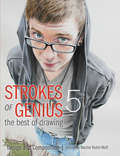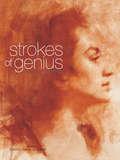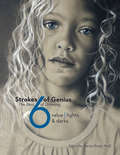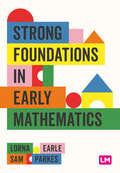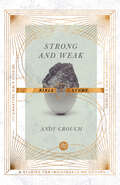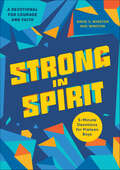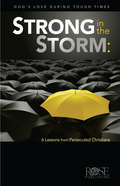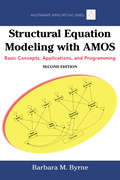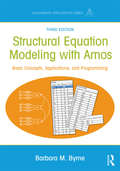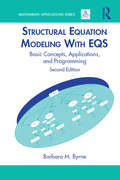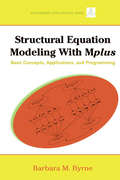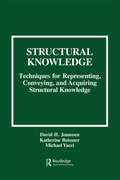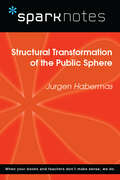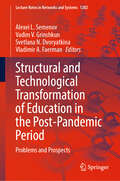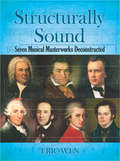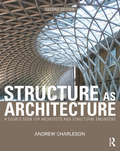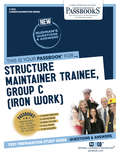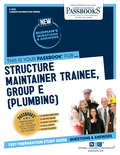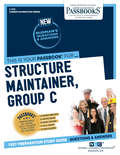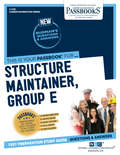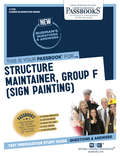- Table View
- List View
Strokes of Genius 5 - The Best of Drawing: Design and Composition (Strokes of Genius: The Best of Drawing #5)
by Rachel Rubin Wolf"Do not only draw what you see," encourages artist Gary Rudisill (p55), "create what you feel." In Strokes of Genius 5, that feeling is delivered through strong and inventive design. Covering a tantalizing range of styles, the work within illustrates the many ways today's best artists choreograph shape, value, line, texture and color into compositions that create drama, tell a story, and pull viewers in. Featuring unusual perspectives, tantalizing contrasts and other dynamic design elements, Strokes of Genius 5 delivers fresh inspiration for artists of every skill level and medium. Art and inspiration from 91 contemporary masters in charcoal, pencil, pastel, colored pencil, scratch board, pen and ink, and more. 120 masterful works--landscapes, figures, portraits, urban scenes, animals and still lifes--in a wonderful diversity of styles. Expert tips, techniques and stories behind the designs.
Strokes of Genius: The Best of Drawing (Strokes of Genius: The Best of Drawing #8)
by Rachel Rubin WolfAwe-inspiring works by contemporary masters, along with the secrets behind its creation.Drawing is the most intimate and immediate form of self-expression, fundamental to every artist's ability to communicate with a viewer. The sense of energy and expression that can be captured in mere strokes of charcoal, ink, pastel, marker or any of the other modest mediums proudly represented in this book is astounding.A glowing celebration of the art of drawing, Strokes of Genius features styles ranging from meticulous realism to imaginative flights of fancy, from lyrical sketches created in minutes to intricately layered renderings that took months to complete.Includes:169 stand-out examples of the finest drawing being done today, selected from hundreds of submissions from around the world.An impressive range of styles, materials and techniques covering a wide array of subjects, including still life, the figure, animals, landscapes, portraits and more.Comments from the artists offer firsthand insight on the creation of each artwork, diverse perspectives on drawing, and fresh ideas and techniques.An incomparable source of inspiration and delight for artists and art lovers, Strokes of Genius contains hundreds of combined years of expertise, artistic breakthroughs and, above all, remarkable drawings that leave a lasting impression.
Strokes of Genius: Value - Lights & Darks (Strokes of Genius: The Best of Drawing #6)
by Rachel Rubin WolfAwe-inspiring works by contemporary masters, along with the secrets behind its creation.Drawing is the most intimate and immediate form of self-expression, fundamental to every artist's ability to communicate with a viewer. The sense of energy and expression that can be captured in mere strokes of charcoal, ink, pastel, marker or any of the other modest mediums proudly represented in this book is astounding.A glowing celebration of the art of drawing, Strokes of Genius features styles ranging from meticulous realism to imaginative flights of fancy, from lyrical sketches created in minutes to intricately layered renderings that took months to complete.Includes:169 stand-out examples of the finest drawing being done today, selected from hundreds of submissions from around the world.An impressive range of styles, materials and techniques covering a wide array of subjects, including still life, the figure, animals, landscapes, portraits and more.Comments from the artists offer firsthand insight on the creation of each artwork, diverse perspectives on drawing, and fresh ideas and techniques.An incomparable source of inspiration and delight for artists and art lovers, Strokes of Genius contains hundreds of combined years of expertise, artistic breakthroughs and, above all, remarkable drawings that leave a lasting impression.
Strong Foundations in Early Mathematics
by Lorna Earle Sam ParkesDeveloping the building blocks for mathematics. This book supports early years teachers and practitioners to enable children to build Strong Foundations in Mathematics. It focuses on children′s learning and development in mathematics in the critical reception year. It supports trainee teachers and early years students to reflect on their own mathematics learning and how this influences their teaching and subject confidence. It acknowledges the uniqueness of the early years and explores the mathematical pedagogies of the EYFS. Importantly, the book challenges the assumption that early years mathematics is ′not proper maths′.
Strong Foundations in Early Mathematics
by Lorna Earle Sam ParkesDeveloping the building blocks for mathematics. This book supports early years teachers and practitioners to enable children to build Strong Foundations in Mathematics. It focuses on children′s learning and development in mathematics in the critical reception year. It supports trainee teachers and early years students to reflect on their own mathematics learning and how this influences their teaching and subject confidence. It acknowledges the uniqueness of the early years and explores the mathematical pedagogies of the EYFS. Importantly, the book challenges the assumption that early years mathematics is ′not proper maths′.
Strong Was Her Faith 22983: Women of the New Testament
by J. Ellsworth KalasIn this follow-up to his book The Thirteen Apostles, popular author J. Ellsworth Kalas focuses on several women of great faith who were crucial, in ways both obvious and understated, to the story of the New Testament. Kalas looks into the life and times of eleven different women. With his signature style, Kalas examines the Scriptures to see what we can learn about these women and what we can learn from them, and how each woman fit into as well as shaped the New Testament story.Chapters include: "Elizabeth: A Friend in Need" "Anna: She Knew How to Wait" "Martha, the Disciplined" "Mary, the Extravagant" "The Mighty Widow" "The Anonymous Evangelist" "Mary Magdalene: When Love Is Greater than Faith" "Mary, the Mother of Mark" "Dorcas: Worth a Miracle" "Lydia, the Businesswoman "Mary in Life and Legend" "Why Mary?" This book also includes a discussion guide.
Strong Women, Soft Hearts: A Woman's Guide to Cultivating a Wise Heart and a Passionate Life
by Paula RinehartRecently updated with an expanded study guide, Strong Women, Soft Hearts has quickly become an important study for women of all ages. Through inspiring real-life testimonies, Paula Rinehart writes as both a kindred spirit and a compassionate counselor to women feeling robbed of their passions and trapped by life's disappointing realities. Women who long to be released from the burden of hard choices and perpetually empty souls will be empowered to rediscover dreams long lost and refocus energy misguided. Strong Women, Soft Hearts cries out for women to embrace passion and approach life as something to be lived, not merely survived.
Strong and Weak Bible Study: Embracing A Life Of Love, Risk And True Flourishing (IVP Signature Bible Studies)
by Andy CrouchThroughout the Bible, we see that God entrusts each of us with authority as his image bearers, even as we remain vulnerable to loss and pain.In these six easy-to-use studies written by spiritual formation author Jan Johnson, you will encounter what Scripture says about power, vulnerability, humble leadership, and flourishing communities.Strong and Weak
Strong in Spirit: 5-Minute Devotions for Preteen Boys
by David S. Winston5-Minute devotions to guide boys ages 9 to 12 in growing up—and growing stronger in faithBeing a preteen means encountering tons of new thoughts, feelings, and information—and sometimes it's hard to know what's right or wrong. This daily devotional for teen boys can help you uncover the truth through God's Word. Spending just a few minutes with God will help you tackle challenges and understand the right path for you.Start each devotion with a short selection from Scripture, explore how each Bible passage can connect to your own life, and journal right in the book. With God's comfort and support, you can meet each day with courage!Go beyond other devotionals for teen boys with:Devotions for your busy life—Each devotion takes just five minutes, and they don't follow a specific order, so you can pick a topic that feels right for the moment.Everyday guidance—Find wisdom to help you navigate real issues like anxiety, crushes, bullying, forgiveness, and being a good friend.Interactive devotions—Go deeper by writing a mini journal reflection, praying, and brainstorming about how you can act on what you learned.Grow stronger in spirit every day with this preteen and teen devotional.
Strong in the Storm: God's Love During Tough Times
by Rose PublishingGod's love through tough times. Strong in the Storm: Six Lessons from Persecuted ChristiansThe lives of persecuted Christians have much to teach us about how God gives courage, peace, and even joy through life's toughest storms. This pamphlet gives 6 lessons we can learn from the persecuted Church and includes six amazing stories of believers who faced incredible hardship.You'll find out where Christians are being persecuted and how you can pray for them. Learn how to apply these lessons of faith, strength, and forgiveness to our own lives. This pamphlet is perfect for a 6-week Bible study or discussion group for adults.Every dayChristians are torturedBecause of their faith in Jesus ChristIn more than 50 countriesBeing a Christianmeans being persecutedIn North KoreaChristians are sent to labor campsTo starve or be killedIn Saudi ArabiaMany Christians have been arrestedOr killed in "honor killings" by their own families.In IranChristians are discriminated againstAnd cannot find or keep jobsTheir lives are on the line every day...Yet they are joyousThey have courageThey have peaceWhat is the secret to being Strong in the Storm?Persecuted Christians want you to know...They are just like youFaithful, flawed, human.Yet they know the six lessons about standing firm for Christ. Now you can hear their stories, andLearn to know God better during times of suffering.The new Strong in the Storm studyWill change your life.Perfect for personal study, prayer groups, or Bible studies. Buy it today.
Structural Equation Modeling With AMOS: Basic Concepts, Applications, and Programming, Second Edition
by Barbara M. ByrneThis bestselling text provides a practical guide to the basic concepts of structural equation modeling (SEM) and the AMOS program (Versions 17 & 18). The author reviews SEM applications based on actual data taken from her research. Noted for its non-mathematical language, this book is written for the novice SEM user. With each chapter, the author "walks" the reader through all steps involved in testing the SEM model including: an explanation of the issues addressed an illustration of the hypothesized and posthoc models tested AMOS input and output with accompanying interpretation and explanation The function of the AMOS toolbar icons and their related pull-down menus The data and published reference upon which the model was based. With over 50% new material, highlights of the new edition include: All new screen shots featuring Version 17 of the AMOS program All data files now available at www.routledge.com/9780805863734 Application of a multitrait-mulitimethod model, latent growth curve model, and second-order model based on categorical data All applications based on the most commonly used graphical interface The automated multi-group approach to testing for equivalence The book opens with an introduction to the fundamental concepts of SEM and the basics of the AMOS program. The next 3 sections present applications that focus on single-group, multiple-group, and multitrait-mutimethod and latent growth curve models. The book concludes with a discussion about non-normal and missing (incomplete) data and two applications capable of addressing these issues. Intended for researchers, practitioners, and students who use SEM and AMOS in their work, this book is an ideal resource for graduate level courses on SEM taught in departments of psychology, education, business, and other social and health sciences and/or as a supplement in courses on applied statistics, multivariate statistics, statistics II, intermediate or advanced statistics, and/or research design. Appropriate for those with limited or no previous exposure to SEM, a prerequisite of basic statistics through regression analysis is recommended.
Structural Equation Modeling With AMOS: Basic Concepts, Applications, and Programming, Third Edition (Multivariate Applications Series)
by Barbara M. ByrneThis bestselling text provides a practical guide to structural equation modeling (SEM) using the Amos Graphical approach. Using clear, everyday language, the text is ideal for those with little to no exposure to either SEM or Amos. The author reviews SEM applications based on actual data taken from her own research. Each chapter "walks" readers through the steps involved (specification, estimation, evaluation, and post hoc modification) in testing a variety of SEM models. Accompanying each application is: an explanation of the issues addressed and a schematic presentation of hypothesized model structure; Amos? input and output with interpretations; use of the Amos toolbar icons and pull-down menus; and data upon which the model application was based, together with updated references pertinent to the SEM model? tested. Thoroughly updated throughout, the new edition features: All new screen shots featuring Amos Version 23.?? Descriptions and illustrations of Amos’ new Tables View format which enables the specification of a structural model in spreadsheet form.???? Key concepts and/or techniques that introduce each chapter. Alternative approaches to model analyses when enabled by Amos thereby allowing users to determine the method best suited to their data.? Provides analysis of the same model based on continuous and categorical data (Ch. 5) thereby enabling readers to observe two ways of specifying and testing the same model as well as compare results. All applications based on the Amos graphical mode interface accompanied by more "how to" coverage of graphical techniques unique to Amos. More explanation of key procedures and analyses that address questions posed by readers All application data files are available at www.routledge.com/9781138797031. The two introductory chapters in Section 1 review the fundamental concepts of SEM methodology and a general overview of the Amos program. Section 2 provides single-group analyses applications including two first-order confirmatory factor analytic (CFA) models, one second-order CFA model, and one full latent variable model. Section 3 presents multiple-group analyses applications with two rooted in the analysis of covariance structures and one in the analysis of mean and covariance structures. Two models that are increasingly popular with SEM practitioners, construct validity and testing change over time using the latent growth curve, are presented in Section 4. The book concludes with a review of the use of bootstrapping to address non-normal data and a review of missing (or incomplete) data in Section 5. An ideal supplement for graduate level courses in psychology, education, business, and social and health sciences that cover the fundamentals of SEM with a focus on Amos, this practical text continues to be a favorite of both researchers and practitioners. A prerequisite of basic statistics through regression analysis is recommended but no exposure to either SEM or Amos is required.
Structural Equation Modeling With EQS: Basic Concepts, Applications, and Programming, Second Edition (Multivariate Applications Series)
by Barbara M. ByrneReaders who want a less mathematical alternative to the EQS manual will find exactly what they're looking for in this practical text. Written specifically for those with little to no knowledge of structural equation modeling (SEM) or EQS, the author's goal is to provide a non-mathematical introduction to the basic concepts of SEM by applying these principles to EQS, Version 6.1. The book clearly demonstrates a wide variety of SEM/EQS applications that include confirmatory factor analytic and full latent variable models. Written in a "user-friendly" style, the author "walks" the reader through the varied steps involved in the process of testing SEM models: model specification and estimation, assessment of model fit, EQS output, and interpretation of findings. Each of the book's applications is accompanied by: a statement of the hypothesis being tested, a schematic representation of the model, explanations of the EQS input and output files, tips on how to use the pull-down menus, and the data file upon which the application is based. The book carefully works through applications starting with relatively simple single group analyses, through to more advanced applications, such as a multi-group, latent growth curve, and multilevel modeling. The new edition features: many new applications that include a latent growth curve model, a multilevel model, a second-order model based on categorical data, a missing data multigroup model based on the EM algorithm, and the testing for latent mean differences related to a higher-order model; a CD enclosed with the book that includes all application data; vignettes illustrating procedural and/or data management tasks; and description of how to build models both interactively using the BUILD-EQ interface and graphically using the EQS Diagrammer.
Structural Equation Modeling with Mplus: Basic Concepts, Applications, and Programming (Multivariate Applications Series)
by Barbara M. ByrneModeled after Barbara Byrne’s other best-selling structural equation modeling (SEM) books, this practical guide reviews the basic concepts and applications of SEM using Mplus Versions 5 & 6. The author reviews SEM applications based on actual data taken from her own research. Using non-mathematical language, it is written for the novice SEM user. With each application chapter, the author "walks" the reader through all steps involved in testing the SEM model including: an explanation of the issues addressed illustrated and annotated testing of the hypothesized and post hoc models explanation and interpretation of all Mplus input and output files important caveats pertinent to the SEM application under study a description of the data and reference upon which the model was based the corresponding data and syntax files available at http://www.psypress.com/sem-with-mplus/datasets . The first two chapters introduce the fundamental concepts of SEM and important basics of the Mplus program. The remaining chapters focus on SEM applications and include a variety of SEM models presented within the context of three sections: Single-group analyses, Multiple-group analyses, and other important topics, the latter of which includes the multitrait-multimethod, latent growth curve, and multilevel models. Intended for researchers, practitioners, and students who use SEM and Mplus, this book is an ideal resource for graduate level courses on SEM taught in psychology, education, business, and other social and health sciences and/or as a supplement for courses on applied statistics, multivariate statistics, intermediate or advanced statistics, and/or research design. Appropriate for those with limited exposure to SEM or Mplus, a prerequisite of basic statistics through regression analysis is recommended.
Structural Knowledge: Techniques for Representing, Conveying, and Acquiring Structural Knowledge
by David H. Jonassen Katherine Beissner Michael YacciThis book introduces the concept of a hypothetical type of knowledge construction -- referred to as structural knowledge -- that goes beyond traditional forms of information recall to provide the bases for knowledge application. Assuming that the validity of the concept is accepted, the volume functions as a handbook for supporting the assessment and use of structural knowledge in learning and instructional settings. It's descriptions are direct and short, and its structure is consistent. Almost all of the chapters describe a technique for representing and assessing structural knowledge acquisition, conveying knowledge structures through direct instruction, or providing learners with strategies that they may use to acquire structural knowledge. These chapters include the following sections in the same sequence: * description of the technique and its theoretical or conceptual rationale * examples and applications * procedures for development and use * effectiveness -- learner interactions and differences, and advantages and disadvantages * references to the literature. The chapters are structured to facilitate access to information as well as to illuminate comparisons and contrasts among the techniques.
Structural Transformation of the Public Sphere (SparkNotes Philosophy Guide)
by SparkNotesStructural Transformation of the Public Sphere (SparkNotes Philosophy Guide) Making the reading experience fun! SparkNotes Philosophy Guides are one-stop guides to the great works of philosophy–masterpieces that stand at the foundations of Western thought. Inside each Philosophy Guide you&’ll find insightful overviews of great philosophical works of the Western world.
Structural and Institutional Transformations in Doctoral Education: Social, Political and Student Expectations (Issues in Higher Education)
by Orlanda Tavares Teresa Carvalho Cristina Sin Sónia CardosoThis book analyses the structural and institutional transformations undergone by doctoral education, and the extent to which these transformations are in line with social, political and doctoral candidates' expectations. Higher education has gone through profound changes driven by the massification and diversification of the student body, the rise of neoliberal policies coupled with the reduction in public funding and the emergence of the knowledge society and economy. As a result, higher education has been assigned new and more outward-looking missions, which have subsequently affected doctoral education. The editors and contributors examine these transformations and changes at the macro, meso and micro levels: wider and more structural changes as well as doctoral candidates' experience of the degree itself. This book will be of interest and value to scholars of doctoral education and the transformation of the university more widely.
Structural and Technological Transformation of Education in the Post-Pandemic Period: Problems and Prospects (Lecture Notes in Networks and Systems #1282)
by Vladimir A. Faerman Alexei L. Semenov Svetlana N. Dvoryatkina Vadim V. GrinshkunCovering both pre-university and university levels, this book addresses the challenges and adaptations in mathematics education during the pandemic. The book "Structural and Technological Transformation of Education in the Post-Pandemic Period" critically examines the changes in STEM education, particularly in mathematics and computer science, prompted by the COVID-19 pandemic. It presents innovative methodologies that incorporate technology into teaching, highlighting the role of ICT in enhancing learning experiences. The focus is on hybrid intelligent systems and data-driven assessment methods that personalize learning and improve educational outcomes. Solutions discussed include the implementation of blended learning models, fostering critical thinking through complex tasks, and using historical contexts to deepen mathematical understanding. This edition serves as a valuable resource for educators, policymakers, and students aspiring to teach in STEM fields, providing insights into the evolving educational landscape.
Structurally Sound: Seven Musical Masterworks Deconstructed (Dover Books on Music)
by Eric WenMusic theorist Eric Wen presents in-depth analyses of seven masterworks from the common-practice period of Western art music:Bach: Air from Orchestral Suite No. 3 in D, BWV 1068 Mendelssohn: Andante con moto tranquillo from Piano Trio No. 1 in D minor, Op. 49 Schubert: Nacht und Traüme, D. 827 Haydn: Adagio — Vivace assai from Symphony No. 94 in G, Hob. I:94 Mozart: Molto Allegro from Symphony No. 40 in G minor, K. 550 Beethoven: Marcia funebre: Adagio assai from Symphony No. 3 in E-flat, Op. 55 Brahms: Un poco presto e con sentimento from Violin Sonata No. 3 in D minor, Op. 108Wen employs the analytic approach developed by Heinrich Schenker, a method that uses musical notation to clarify and illuminate a work's structural hierarchies. Copiously illustrated with analytic musical examples that elucidate the tonal organization of each of the seven works, this study also explores aspects of form, rhythmic organization, and programmatic meaning. This volume will be of particular interest to musicologists and professional musicians, and it will also appeal to listeners keen to probe the rich complexities of these masterpieces.
Structure As Architecture: A Source Book for Architects and Structural Engineers
by Andrew CharlesonStructure as Architecture presents a comprehensive analysis of the indispensable role of structure in architecture. An exploration, as well as a celebration, of structure, the book draws on a series of design studies and case study examples to illustrate how structure can be employed to realize a wide range of concepts in contemporary architecture. By examining design principles that relate to both architecture and structural engineering, Andrew Charleson provides new insights into the relationship between both the technical and aesthetic aspects of architecture. Now in its second edition, the text has been extensively revised and updated throughout. Features include: A brand new chapter on hidden structure, adding to the material on exposed structures Two new chapters on using structure to realise common architectural concepts through a combination of precedents and creative design Over 50 new case studies from across the globe Easy-to-understand diagrams and a highly visual design to aid understanding and accessibility More than two hundred case studies of contemporary buildings from countries such as the UK, the US, France, Germany, Spain, Hong Kong, Australia and Japan illustrate how a thorough integration of structure adds layers of richness and enhances the realisation of architectural design concepts.
Structure Maintainer Trainee, Group C: Passbooks Study Guide (Career Examination Series)
by National Learning CorporationThe Structure Maintainer Trainee, Group C (Iron Work) Passbook® prepares you for your test by allowing you to take practice exams in the subjects you need to study. It provides hundreds of questions and answers in the areas that will likely be covered on your upcoming exam, including but not limited to: Fundamentals of the sheet metal trade, including the proper selection, use and care of tools, material and equipment used in the sheet metal work; Reading and understanding technical drawings; Performing job-related arithmetic; Safe work practices; and more.
Structure Maintainer Trainee, Group E: Passbooks Study Guide (Career Examination Series)
by National Learning CorporationThe Structure Maintainer Trainee, Group E (Plumbing) Passbook® prepares you for your test by allowing you to take practice exams in the subjects you need to study. It provides hundreds of questions and answers in the areas that will likely be covered on your upcoming exam, including but not limited to: fundamentals of the plumbing trade, including the proper selection, use and care of tools, materials and equipment used in plumbing work; reading and understanding technical drawings; performing job-related arithmetic; safe work practices, including basic first-aid procedures; and more.
Structure Maintainer, Group C: Passbooks Study Guide (Career Examination Series #C-1776)
by National Learning CorporationThe Structure Maintainer, Group C (Iron Work) Passbook® prepares you for your test by allowing you to take practice exams in the subjects you need to study. It provides hundreds of questions and answers in the areas that will likely be covered on your upcoming exam, including but not limited to: fabricating and repairing structural and ornamental ironwork; operating machines and tools of the ironwork trade; burning, rigging and welding; reading sketches, drawings and prints; safety procedures; and more.
Structure Maintainer, Group E: Passbooks Study Guide (Career Examination Series)
by National Learning CorporationThe Structure Maintainer, Group E (Plumbing) Passbook® prepares you for your test by allowing you to take practice exams in the subjects you need to study. It provides hundreds of questions and answers in the areas that will likely be covered on your upcoming exam, including but not limited to: plumbing supplies and materials; proper and efficient use of tools; safe plumbing procedures and the plumbing code; reading and interpreting blueprints, schematics and technical drawings related to the plumbing trade; and more.
Structure Maintainer, Group F: Passbooks Study Guide (Career Examination Series #C-1776)
by National Learning CorporationThe Structure Maintainer, Group F (Sign Painting) Passbook® prepares you for your test by allowing you to take practice exams in the subjects you need to study. It provides hundreds of questions and answers in the areas that will likely be covered on your upcoming exam, including but not limited to: Select words and symbols for the design of effective signs; Ability to proportion letters and symbols on signs; Ability to use brushes and other equipment used in the production of freehand lettered signs; Knowledge of paints, brushes and other materials related to the various methods of production of signs; and more.
